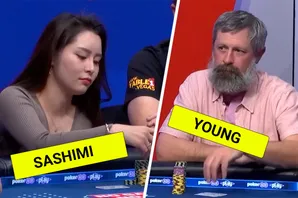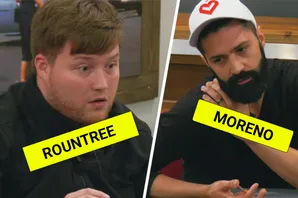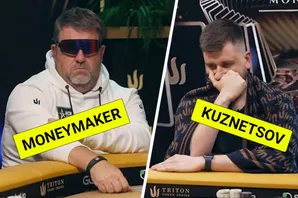You can't play poker if you don't have any money. And while you may find long-winded strategy advice boring, contradictory, and not worth the hassle, remember this: you can't even play bad poker if you don't have any money.
You simply can't afford to discount bankroll management advice, whatever your poker ambitions.
Happily, much of what you need to know about bankroll management can fit into a single chart. If you remember it, or remember where you can find it, you should be able to stay in control of your bankroll and continue to play poker for as long as you like.
For cash games, the chart looks like this:
| BLINDS | MAX BUY-IN | PASSIVE (LIVE) GAMES | INTERMEDIATE | VOLATILE (ONLINE) GAMES |
|---|---|---|---|---|
| 1c/2c | $2 | na | $100 | $200 |
| 2c/5c | $5 | na | $250 | $500 |
| 5c/10c | $10 | na | $500 | $1,000 |
| 10c/25c | $25 | na | $1,250 | $2,500 |
| 25c/50c | $50 | na | $2,500 | $5,000 |
| 50c/$1 | $100 | na | $5,000 | $10,000 |
| $1/$2 | $200 | $4,000 | $10,000 | $20,000 |
| $2.5/$5 | $500 | $10,000 | $25,000 | $50,000 |
| $5/$10 | $1,000 | $20,000 | $50,000 | $100,000 |
| $10/$20 | $2,000 | $40,000 | $100,000 | $200,000 |
In case it's not obvious, the column on the left shows the blinds for a given cash game. The next column is the typical maximum buy-in for that kind of table. And the columns on the right show the bankroll you'll need to play that game -- a range from the smallest recommended bankroll, for people prepared to fly closer to the wind or who are sitting in passive live games, through to the most cautious bankroll, required for the volatile online tables.
Experts vary from recommending at least 20 buy-ins in your overall bankroll before sitting at any given game, to at least 100.
Getting to your figure requires having a solid understanding of what a "buy-in" is, then a knowledge of and an acceptance of the variance inherent in all poker. Once you know this, and you know how you tend to fare at various levels, you can figure out the bankroll you’ll need to play where you want.
How to calculate and manage your poker bankroll
Almost all cash game tables, whether live or online, have a minimum and a maximum permitted buy-in. (The exceptions tend to be nosebleed games, which can sometimes be uncapped.)
The buy-in restrictions are designed to ensure nobody can skew the game unfairly by sitting down with so many chips that everyone else might immediately go broke, while also deterring short-stackers, who will essentially just take up a seat without any real prospect of playing a long session.
Although some games are advertised as "deep", allowing players to buy-in with a slightly bigger stack than normal, the maximum buy-ins online tend to be 100 times the big blind. (They are slightly bigger in live cash games.)

If you want to be able to play your best poker, you need to have the chips in front of you to allow you to do it. For this reason, it's almost always best to buy in for the maximum: it will let you make the right hero calls if you think that's the correct play, and you'll be sufficiently well armed to pull off a strong bluff, if the situation demands.
When we're talking about buy-ins, therefore, we mean the maximum permitted buy-in for the table. You’re going to sit down with as much as you’re allowed, and you’re going to top up to that level too if you decide to stick around after some early hiccups.
The role of variance in poker bankroll management
Ah yes, variance. The thing about poker is that no matter how good you are, no matter how perfect your decision making, you’re still going to lose plenty of pots.
You absolutely must be able to cope with the highs and lows of poker, both emotionally and financially. It’s a game full of swings.
While there’s no certain formula for preventing your emotions from spiralling out of control, that chart above, laying the foundations for solid bankroll management skills, will mean you can always ride out the financial uncertainty.
Let’s say you only ever sit at a table when your bankroll is comfortably more than 50 times the maximum buy-in. This means you can lose your entire stack 49 times and still fire again. You’d have to be impossibly unlucky to lose 50 stacks owing to variance alone – and if you discover you’re actually losing because you’re not good enough, you’ll soon learn your lesson and drop down to easier games.
Maximizing your poker profits through effective bankroll management
You should always be looking to create conditions that allow you to play your best. That’s why you buy in for the maximum, and why you always need to have plenty of buy-ins in reserve.
In Daniel Negreanu's Masterclass, he remembers the "pretty dumb decision" he made when he was a young player and took his entire bankroll of $30K to a $1,500/$3,000 game. "That gave me 10 bets, 10 blinds," Negreanu says. "That's just poor bankroll management. Don't try this at home."
Even a player of Negreanu’s quality can’t expect to play his best game when he knows that if he loses one 60/40, he’s broke. He needs a buffer. You need a buffer. Every poker player needs a comfort zone to ride out the variance.
The 20-100 buy-in range represents this comfort zone. You can decide at what end you want to place yourself.

The good thing about the chart above is that you can read it in either direction. If you have a buy-in of, say, $500, you can determine that you can play 2c/5c comfortably, or somewhere close to 10c/25c at the riskier end of things.
Conversely, if you’re desperate to play $5/$10, you know you need a bankroll of at least $20K, and probably closer to $100K, to play this game within your means.
Why bankroll management is essential for poker success
Bankroll challenges have become common among poker pros. They attempt to run up a miniscule bankroll to a five or six-figure sum, mainly to prove how great they are that anybody can do it if they apply solid bankroll management skills.
In the years before he found a less moral approach to taking poker players’ money, Chris Ferguson initiated one of the first bankroll challenges, grinding out a roll of $10,000 after starting out playing only freerolls and then progressing through the online micro-stakes tables.
He adhered to most of the rules outlined above, but also added this stipulation: if you manage to build a stack of in a cash game that’s bigger than 10 percent of your total bankroll, cash it out.
This is important. While it may be tempting to ride a rush, it’s more important to fix a goal and then walk away when you’ve achieved it. That way you can lock up your winnings and prepare for the next step afresh.
Some important additional factors
Live vs. online: You’ll see many more hands in an online session than you will in the same period playing live. You’ll need to expect more swings and have a bigger bankroll to play online than you would in live games with equivalent stakes. Doug Polk, for instance, talks specifically about online games when he recommends 100+ buy-ins, and suggests as little as 20-40 are needed for live play.
Short-handed vs. full-ring: Good short-handed strategy means playing a wider range of hands than in a full ring game, and it follows that this too will enhance the variance. When the variance goes up, your number of buy-ins should do too. You’ll need a bigger bankroll if you’re preparing to play short-handed – 20 percent more buy-ins to play six-handed than nine-handed, for example.
Limit HE vs. NLHE vs. PLO: It’s much harder to get your whole stack in while playing limit hold’em than it is when playing no limit. Omaha tends to be an even more swingy game than hold’em. Just remember that every time you introduce more variance, be it through a change in betting structure or poker variant, you need to increase the buy-ins in your bankroll. You’ll need either more buy-ins for PLO cash games, or to play at lower stakes.
Tournament poker bankroll management

Poker tournaments are a minefield. Variance here is enormous, even for the game’s elite talents, and by common agreement, any MTT poker bankroll needs to have at least 100 buy-ins in it, and maybe up to 300.
In other words, you should never risk any more than one percent of your total poker bankroll in any single tournament. You need to prepare to whiff repeatedly, and sometimes settle for a min-cash, all the while staying in the tournament game long enough to one day snatch that big score.
In a recent interview, the British pro Sam Grafton, who progressed through the ranks to play Super High Roller events, said, “Even now, if you started me off with $2,200, I wouldn't go off and play $100 buy-in tournaments. I would allow myself a lot of shots at $22 tournaments.”
The bankroll management chart for tournaments therefore looks like this:
| BUY-IN | MINIMUM BANKROLL (100 BUY-INS) | CONSERVATIVE BANKROLL (300 BUY-INS) |
|---|---|---|
| $1 | $100 | $300 |
| $2 | $200 | $600 |
| $5 | $500 | $1,500 |
| $10 | $1,000 | $3,000 |
| $20 | $2,000 | $6,000 |
| $30 | $3,000 | $9,000 |
| $50 | $5,000 | $15,000 |
| $100 | $10,000 | $30,000 |
| $500 | $50,000 | $150,000 |
| $1,000 | $100,000 | $300,000 |
While it may seem ridiculous to not play a $1 tournament online unless you have $300 in your account, just bear in mind that you’re also not likely to be winning huge sums in these kinds of games. You can of course probably afford multiple attempts at tournaments of this size without going broke, but you might find that building a bankroll purely through micro-stakes MTTs takes a very long time.
Rebuys/re-entries and turbos/hyper-turbos
There’s a lot of choice for tournament players in modern poker, all of which alter bankroll management concerns. As ever, it’s all about monitoring how much more variance enters the game depending on the tournament type.
As with cash games, short-handed tournaments introduce more variance, so you’ll need a bigger bankroll if you’re going to play six-max events. And any tournament where the blind levels are short is necessarily more swingy. So if you’re feeding off a diet of turbos and hyper-turbos, you’ll need to prepare for spikes and slumps.
You also need to remember that relatively few tournaments these days, either live or online, are freezeouts. It means that although a tournament might have a $10 entry fee, you should be prepared to re-enter a couple of times if necessary. That $10 tourney is potentially a $30 event.
All of these things push up the overall bankroll you’ll need to play.
Spreading the risk

When a high roller sits down and plays a $100K buy-in tournament, it doesn’t mean he has $10 million in his bankroll – even though you can be sure he practices solid bankroll management. He’ll still probably only have about one percent of his bankroll in play.
High rollers take on backers when they play these huge events, and they also swap percentages with friends and fellow competitors. This is a way of spreading the risk, and it’s something you can do at all stakes. If you want to play a $100 buy-in tournament but don’t have the bankroll, offer $10 pieces to friends. There’s no minimum to this kind of thing.
Of course, you’ll need to pay out to your backers when you have a score, but your bankroll will be padded too thanks to them.
PokerOrg’s Bankroll section is brought to you in association with MuchBetter, the award-winning e-wallet that lets you store, send, and move money quickly and easily.



























